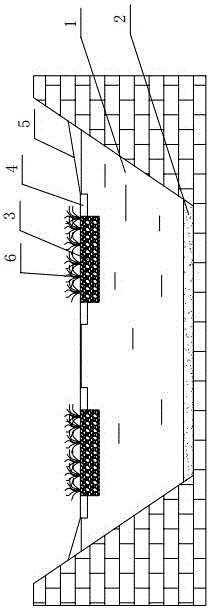Seepweed and portunus trituberculatus co-cultivating mode in seawater pond
A swimming crab and pond technology, applied in fish farming, climate change adaptation, botanical equipment and methods, etc., can solve the problems of easy pollution, polluting the environment, increasing breeding costs, etc., and achieve improved survival rate, high income, and meat fat cream thick effect
- Summary
- Abstract
- Description
- Claims
- Application Information
AI Technical Summary
Problems solved by technology
Method used
Image
Examples
Embodiment Construction
[0011] like figure 1 As shown, a seawater pond co-culturing mode of Suaeda and swimming crabs, swimming crabs are cultured at the bottom of the pond 1, and Suaeda 6 is planted on the water surface.
[0012] Pond 1 is arranged on the coastal area, and is convenient to take fresh seawater to inject pond 1, and pond 1 area is 5 to 20 mus, and pond 1 water depth is 1.5 to 2.0 meters. The bottom of the pond 1 is a sand layer 2, and the thickness of the sand layer 2 is 15 to 25 cm. Put young crabs in May-June, 400 tails per 100 square meters, and the sand layer 2 is the place for the growth and activities of swimming crabs.
[0013] There are planting racks floating on the water surface of the pond 1, and the area of the planting racks is 16 to 32 square meters, and 2 to 3 are set on every hundred square meters of water surface. The planting frame includes a base body 3 and a floating body 4 fixed around the base body 3, so that more than 80% of the volume of the base body 3 is ...
PUM
| Property | Measurement | Unit |
|---|---|---|
| Area | aaaaa | aaaaa |
Abstract
Description
Claims
Application Information
 Login to view more
Login to view more - R&D Engineer
- R&D Manager
- IP Professional
- Industry Leading Data Capabilities
- Powerful AI technology
- Patent DNA Extraction
Browse by: Latest US Patents, China's latest patents, Technical Efficacy Thesaurus, Application Domain, Technology Topic.
© 2024 PatSnap. All rights reserved.Legal|Privacy policy|Modern Slavery Act Transparency Statement|Sitemap

